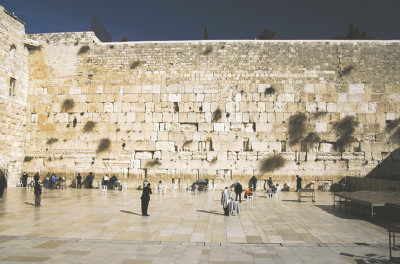
This week, we dropped off our son Shalom at Newark International Airport as he departed for his second year of learning at Yeshiva Mercaz HaTorah in Yerushalayim.
Thankfully, it was a vastly better experience than last year. Last year’s flight was from JFK International Airport, and we got stuck in standstill traffic before the George Washington Bridge. Thankfully, we made it to the airport. This was also during the days of masks and impossibly numerous forms and visas, adding stress to an already stressful situation.
Last year, Shalom arrived in Yerushalayim like most first-year yeshiva talmidim, not knowing what to expect, where to go, or how to get there. In addition to the emotional roller coaster of sending a child off for a year, there is the added anxiety of wondering how he/she is going to manage and get around without his/her parents.
I had the great fortune to visit Shalom last winter. Among the other highlights of my trip, I was impressed at how well Shalom and his friends knew the Jerusalem metro system. I couldn’t believe that some of these boys who need a GPS to get from their house in the United States to the local supermarket (for reasons of confidentiality, I will not write whether Shalom fits into that category), could navigate Yerushalayim with ease. They were all very familiar with which buses to take to get to various neighborhoods, where to pick up the light rail and at which stops to get off.
I loved hearing them discuss various streets, landmarks, and neighborhoods: Har Nof, Wolfson, Bayit Vegan, the Kotel, Yaffo, the Tachana, Mattesdorf, Shmuel HaNavi, Meah She’arim/Geulah, Machane Yehuda, town…They also are experts in all the best places to eat: where to get the best shawarma, how to find decent pizza in Israel with that Israeli pizza sauce, the best bakeries, and of course marzipan in the Shuk (true Oneg Shabbat).
During the COVID lockdown, someone posted a soundless video simply walking through Sha’ar Yafo and through the old city to the Kotel. The video evoked incredible nostalgia and yearning, especially during that difficult time of isolation. The familiar walk from Yafo, through Omar Ibn El-Khattab Square, making a left turn onto Saint James and proceeding on the beautiful ancient narrow pathway leading from the Armenian quarter into the Jewish Quarter. Then continuing down the narrow alleyway on the cold stones, passing the Churvah and Ramban shuls, through the rova (open square), and past all the restaurants, until finally arriving at the Rabbi Yehuda HaLevi steps, next to the golden menorah. Then, making the turn and beginning the descent, seeing the Kotel and the plaza become visible in its tragic majesty. Even merely watching it granted the feeling of having arrived at the central, focal point of the world.
In Parsha Re’eh, the Torah instructs us: “You shall inquire after His dwelling and come there.” Ramban explains that “there” refers to the future Beit HaMikdash. Hashem never directly revealed the site upon which the Beit HaMikdash was to be constructed. The nation was told that they had to intuit the proper place. Dovid Hamelech, in fact, did so. It was only after he determined the Temple Mount that the prophet Gad confirmed his choice.
Rav Menachem Mendel of Vitebsk was a student of the Maggid of Mezeritch. In 1777, after the passing of the Maggid, Rav Menachem Mendel, accompanied by 300 chasidim, traveled to Eretz Yisrael, first in Tz’fas, and later in Tiberias. His shul still stands in Teveriah.
After settling in Eretz Yisrael, Rav Menachem Mendel was once asked if there was anything he missed from when he lived outside Eretz Yisrael. He replied that he missed the constant yearning for Eretz Yisrael that he used to feel before he immigrated there.
We take it for granted that we have the capability to visit and travel through Eretz Yisrael, to wander the streets of Yerushalayim, and to visit the Kotel.
When I tell my students that from 1948 to 1967 the holy city was Jundenrein, they are stunned. During those years, if a Jew even traveled too close to the city, he was in danger of being killed by Jordanian snipers. Similarly, a Jew could not visit Kever Rachel or Ma’arat Hamachpeilah.
After those holy sites were miraculously recaptured during the Six-Day War, Rabbi Aryeh Levin noted that he was concerned that we shouldn’t take the gift of being able to visit those places constantly for granted.
The Torah never tells us the site of the Beit HaMikdash, in order to arouse within us a sense of excitement to uncover the mystery and majesty of that sought-after place.
Eretz Yisrael, and more specifically, Yerushalayim, are places that need to be constantly yearned for. The very name “Yerushalayim” was a source of comfort and yearning throughout the millennia of exile.
I’m not sure if speaking about the various neighborhoods of Yerushalayim is somewhat of a fulfillment of the injunction to “inquire after His dwelling.” But it sure is a lot more special than discussing the streets and neighborhoods of London, Paris, or New York. When Mashiach comes, soon, we will all need to be familiar with the Jerusalem metro system and the street names (and where to buy marzipan for Shabbat). I’m gratified that Shalom and his friends have gotten a head start.
Rabbi Dani Staum LMSW is the Rabbi of Kehillat New Hempstead, as well as a rebbe and Guidance Counselor at Heichal HaTorah in Teaneck, NJ, Principal at Mesivta Ohr Naftoli of New Windsor, and a Division Head at Camp Dora Golding. He can be reached at: This email address is being protected from spambots. You need JavaScript enabled to view it.. Looking for “Instant Inspiration” on the parsha in under 5 minutes? Follow him on www.Torahanytime.com.
Seeking…
Typography
- Smaller Small Medium Big Bigger
- Default Helvetica Segoe Georgia Times
- Reading Mode










